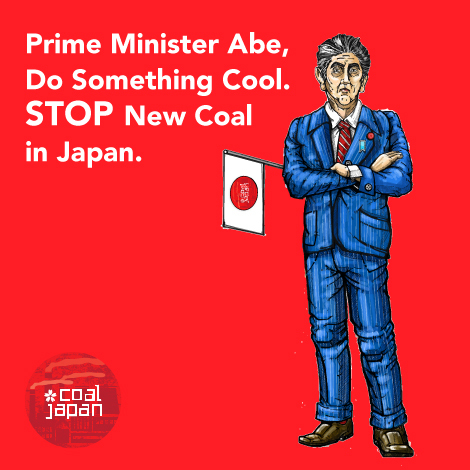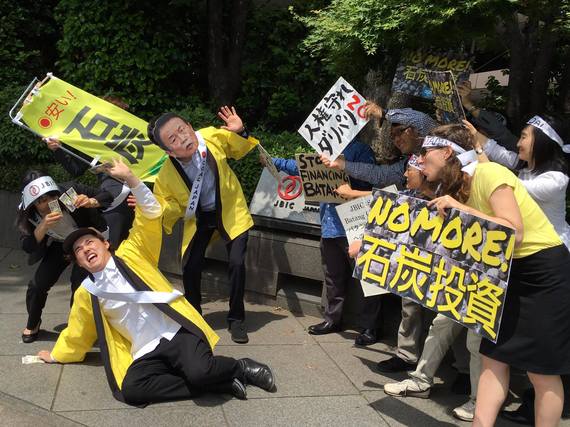[このブログは日本ダイベストメントキャンペーン担当の古野真がハフィントンポストへ投稿したブログである。 English below.]
G7伊勢志摩サミットに合わせて、日本の石炭推進の状況を世に知らしめるべく、「コールジャパン」キャンペーンを私たちは始動することにした。日出る国日本を「コール」な国から真に「クール」な国へと変えることが、「コールジャパン」の目的だ。
今週末三重県伊勢志摩で行われるG7伊勢志摩サミットを直前に迎え、現在世界中の目が日本の動向に向けられている。
G7が開催される伊勢志摩には日本が世界に誇る文化の象徴、伊勢神宮がある。またそれ以外にも、最先端テクノロジーやユニークなアートなど、日本は世界に誇るべき「モノ」や「文化」で溢れている。
このような「日本の魅力」を日本政府は組織的に世界に発信しており、その中でも代表的なキャンペーンが経済産業省が進める「クールジャパン」だ。
しかし、果たして日本は本当に「クール」なのだろうか?
あまり知られていないことだが、日本は現在石炭火力発電所を国内に47基新設する計画を進めている。これは他のG7諸国の脱炭素計画に真っ向から逆行する動きであり、石炭推進について日本はG7の中で完全に孤立している。
また、日本は他のG7諸国とは比べようのないほど巨額な公的資金を石炭関連プロジェクトにつぎ込んでいる。その額は2007年から2014年の間に2000億ドルに登る。日本には「クール」より「コール(石炭)」の呼び名の方が、はるかにお似合いのようだ。
近年では、G7の米国、英国やフランスなどが石炭事業への国際的支援に対する規制を厳しくしており、これらの国々は国内でも次々と石炭火力発電所を廃止している。イギリスはすでに完全な脱石炭化を達成しつつあり、アメリカも古い石炭火力発電所を急ピッチで閉じている。その数は過去5年間の間で200以上に達している。
しかし、日本は相変わらず世界一の海外石炭事業推進国として邁進しており、脱炭素化へと進む世界から次第に見放されている。
コールは一切クールではない。
石炭(コール)は自然環境にも人々の暮らしにも壊滅的な影響をもたらす地球温暖化の主な原因である。そして皮肉なことに、日本は気候変動による被害をもっとも大きく受ける国の一つなのだ。例えば、地球の平均気温が4度上昇すると、首都圏でも750万人が海面上昇による被害を受けると言われている。2度の上昇の場合でも420万人分の世帯が浸水すると言われている。
このような深刻な影響があるからこそ、2015年のG7では21世紀後半までに完全に脱炭素化した世界を目指すことが合意されたのだ。さらに、2015年の末にパリで開催された気候変動に関する国際会議では、2050年までに完全なる脱炭素社会を実現することが、世界195カ国により合意された。
言い換えると、温室効果ガスを大量に排出する石炭をエネルギー原として使用することはもはや不可能であり、「石炭にはもう未来が無い」と日本を含む世界が合意したのだ。そして上記の合意を達成するため、世界は温室効果ガスの大幅な削減と、再生可能エネルギーの導入を急速に加速させることが求められている。
一方、世界と結んだ約束とは裏腹に、国内で石炭火力発電所の新設を進め、世界の石炭事業を支える日本は完全に孤立している。しかも、日本は消費する石炭の100%をオーストラリアやインドネシアといった海外から輸入しているのだ。このまま石炭や化石燃料依存を続けると、国はエネルギー自給率を向上できず、また世界経済の不安定性にさらされることになる。
では一体、何が「コールジャパン」を支える原動力となっているのか?
その答えはすばり「お金の流れ」である。日本の公的金融機関や民間銀行、または機関投資家が運用するお金が、大手一般電力会社などへと流れている。これらの企業は自らの利益を守るために、再生可能エネルギーの導入や成長を、あらゆる手を使い抑えているのだ。
去年私たち「350.org Japan」が行った調査により、日本のメガバンクグループ(三菱東京UFJ、みずほ、三井住友銀行、三井住友信託銀行)が化石燃料や原発に関わる企業へ巨額な投資や融資を行っていることが明らかになった。2014年度での投融資総額は、なんと5兆3890億円にまで登った。
同報告書により、日本の生命保険会社も化石燃料・原発関連企業に約4兆3千億円の投資を行っていることが明らかになった。
しかし、同時に希望の光が差し込んでいるのも事実である。日本の金融と環境技術の力を持続可能なエネルギーに集中させれば、日本は必ず自然エネルギーの世界的リーダーになれる。日本では毎年約200億米ドルが新たな自然エネルギープロジェクトに投資されており、これにより年間800万キロワット(kW)の新たな電源が供給されている。これまでなんども大きな改革を成し遂げてきた日本は、世界の先を行く環境大国に成り上がるポテンシャルを十分に秘めている。
G7 が間近へと迫る中、日本は選択を迫られている。「コール」を選ぶのか、それとも「クール」を選ぶのか。世界は私たちの答えを待っているのだ。
350.org Japanは日本も正しい方向へと導くために、「#DivestJapan」キャンペーンを通して、日本の市民、銀行、生命保険会社、年金基金や公的機関が化石燃料や原子力に関わる企業から「ダイベストメント」(=投資撤退)をするよう呼びかけている。そして、ダイベストメントして引きあげた資金を、持続可能な開発を支える自然エネルギーなどへ転換することを提案している。詳しい情報は公式ホームページ www.350.org/ja にてご覧ください。
現在のお金の流れを持続可能な開発へと転換できれば、私たちは真に「クールジャパン」として世界から賞賛されるだろう。
With the eyes of the world on Japan for this week’s G7 meeting in Ise-Shima, the government will be hoping to show off the best of our country.
The town of Ise-Shima itself is home to the one of the most revered Shinto shrines in Japan and a proud part of our history. But the government is also about promoting the nation’s cutting-edge art, technology and culture abroad.
At the heart of this is – Cool Japan – a PR campaign run by the Japanese Ministry of Economy, Trade and Industry.
But it seems like coal is the new cool, because it’s a little known fact that unlike its G7 partners, Japan is in the process of building 49 new coal-fired power stations – whilst also being by far and away the largest financial backer of coal infrastructure in the region.
From 2007 to 2014, Japan provided over US$20 billion in coal financing abroad.
While the US, the UK, France and other countries have placed restrictions on their financing of coal projects abroad, and are actively shutting down existing plants, Japan remains the world’s number one supporter of overseas coal.
That’s why this week we’re taking part in the launch of the brand-jamming Coal Japan, which aims to let the world know what’s quietly going on in the land of the rising sun.
Because let’s face it, there’s not much cool about coal.
The Coal Japan campaign aims to show the world that Japan’s plans for 49 new coal-fired power plants are far from cool
Ironically, Japan will be one of the world’s most affected countries by sea-level rise, with 7.5 million people – 30 percent of Tokyo’s population – affected by the sea level rise under a 4 degrees Celsius scenario in the capital alone. A rise by 2 degrees Celsius would leave 4.2 million people’s homes underwater.
Coal is climate change and climate change is catastrophe.
A Climate Central report shows that 7.5 million residents of Tokyo would be affected by sea level rise under a 4 degrees Celsius scenario
Which is why at the last G7 in 2015, members agreed that the decarbonisation of the global economy should be completed by the end of this century: requiring deep cuts in CO2 emissions and big changes in how we power our planet. In Paris, under the Paris Climate Agreement, this goal for decarbonisation was brought forward to zero emissions by 2050.
This means that G7 leaders, including Japan, agreed there is no future for coal in a world that is acting to avoid dangerous climate change.
And the G7 is moving away from coal. The UK has totally kicked the habit and the USA is rapidly retiring old coal plants, with over 200 shut in the last five years and more closing their doors every week.
Japan is the odd one out as only country in the G7 building new coal-fired power stations, despite promising the rest of the world to do the opposite.
And this is also despite having to import all its coal from abroad, mainly from Australia and Indonesia.
So what’s with Coal Japan?
350 Japan campaigners protest against the country’s coal policy last week
The answer lies in the flow of both public and private finance from Japan’s banks and institutional investors to major power corporations such as TEPCO, whose interests are to restrict new renewable energy power generation that will disrupt their business model.
A survey commissioned by 350.org Japan revealed that the investments in, and loans to corporations related to fossil fuels, new domestic coal-fired thermal power facilities and nuclear power-related companies by Japan’s mega-banking groups – including Tokyo Mitsubishi UFJ, Mizuho, Mitsui Sumitomo and Mitsui Sumitomo Trust – amounted to approximately 5.389 trillion Japanese Yen in 2014.
This survey also found that Japan’s major life insurance companies have investments and loans totalling 4.330 trillion Japanese Yen in companies connected to fossil fuels and nuclear power.
All the big names are there and they’re not keen on renewable energy shaking the apple cart.
But the bright side is that Japan can be a renewable energy powerhouse by directing its financial and technological might towards clean energy. With almost US$20 billion invested annually in new solar developments that are bringing 8 gigawatts (GW) of solar-powered electricity online per year, Japan is one of the three largest solar installation markets globally.
So as the G7 comes around we’re at a major cross-roads. Are we going to be seen by the world as Cool Japan, or Coal Japan?
Which is why we’re asking individuals, Japan’s banks, insurance companies, pension funds and all public organizations that they divest from corporations linked to fossil fuels and nuclear power, and transition these investments towards the development of renewable energy – through the #DivestJapan campaign.
It can be done. It must be done. And then we really would be Cool Japan.



